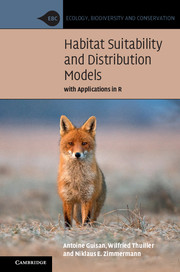Book contents
- Habitat Suitability and Distribution ModelsWith Applications in R
- Ecology, Biodiversity and Conservation
- Habitat Suitability and Distribution Models
- Copyright page
- Contents
- Foreword
- Preface
- Acknowledgments
- Authors’ Contributions
- Introduction
- 1 General Content of the Book
- Part I Overview, Principles, Theory, and Assumptions Behind Habitat Suitability Modeling
- Part II Data Acquisition, Sampling Design, and Spatial Scales
- Part III Modeling Approaches and Model Calibration
- Part IV Evaluating Models: Errors and Uncertainty
- Part V Predictions in Space and Time
- Part VI Data and Tools Used in this Book, with Developed Case Studies
- Part VII Conclusions and Future Perspectives
- Glossary and Definitions of Terms and Concepts
- References
- Index
- References
References
Published online by Cambridge University Press: 14 September 2017
- Habitat Suitability and Distribution ModelsWith Applications in R
- Ecology, Biodiversity and Conservation
- Habitat Suitability and Distribution Models
- Copyright page
- Contents
- Foreword
- Preface
- Acknowledgments
- Authors’ Contributions
- Introduction
- 1 General Content of the Book
- Part I Overview, Principles, Theory, and Assumptions Behind Habitat Suitability Modeling
- Part II Data Acquisition, Sampling Design, and Spatial Scales
- Part III Modeling Approaches and Model Calibration
- Part IV Evaluating Models: Errors and Uncertainty
- Part V Predictions in Space and Time
- Part VI Data and Tools Used in this Book, with Developed Case Studies
- Part VII Conclusions and Future Perspectives
- Glossary and Definitions of Terms and Concepts
- References
- Index
- References
Summary

- Type
- Chapter
- Information
- Habitat Suitability and Distribution ModelsWith Applications in R, pp. 417 - 457Publisher: Cambridge University PressPrint publication year: 2017

